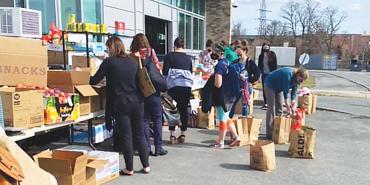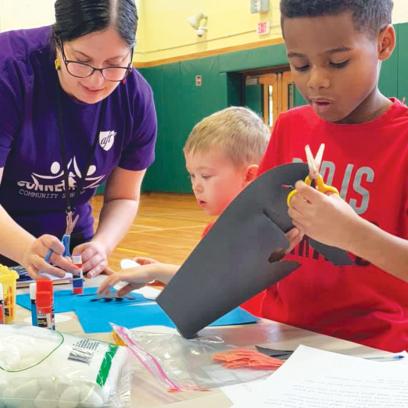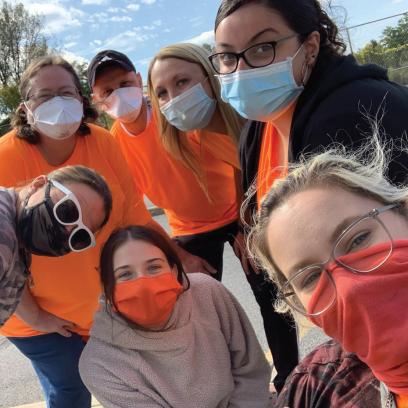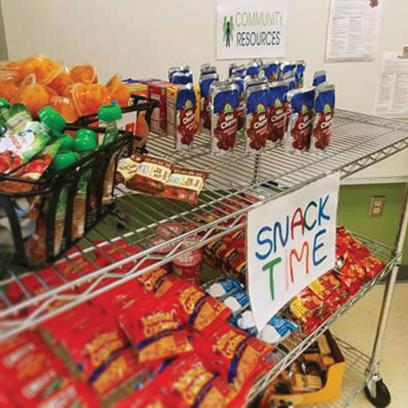Devina Love moved to Rome, New York, in August last year after fleeing domestic violence in Massachusetts. She enrolled both of her young sons at Francis Bellamy Elementary—and soon their world started to brighten. Bellamy, which became Rome’s first community school in 2015, offered an array of services. From food to school supplies to a staff genuinely tuned in to families’ emotional needs, Bellamy offered far more than an education to Love and her sons.
Love felt it right away. “We come with kind of an array of issues and a complex situation that required a lot of love and compassion and a lot of empathy from people we honestly don’t know,” she says. Joe Renzi, a school counselor at Bellamy, told Love about a variety of supports provided through the local community schools initiative. Soon, Renzi was offering counseling to her sons in school, while Love was receiving mental health supports from an outside agency.
Love recalls the time this past winter when the community schools operations manager* asked her what specifically her family could use. Besides food, Love said her younger son needed a snowsuit. Her older son had gotten one for Christmas, but she didn’t have the money to purchase one for her 6-year-old. Soon after, the manager came to Love’s apartment with a brand-new snowsuit. She also arrived with two new pairs of snow boots. “They were so excited,” Love says. “They were like, ‘Mommy, now we can go play in the snow!’ ”
Community schools like Bellamy show what’s possible when we all band together to prioritize healthy youth development and family well-being. Bellamy’s extensive and customized array of services was seven years in the making—and is still being refined and enhanced.
Back in 2013, Joe Eurto first heard of community schools at a conference in New York City that was held by the AFT’s Center for School Improvement, which focuses on creating labor-management partnerships to foster sustainable changes. A longtime middle school English teacher in Rome, Eurto could not stop thinking about all the good community schools would do for his students.
At the conference, he learned that community schools serve as the hubs of their communities by providing wraparound services and enrichment opportunities to students and families in need. He learned that if children lack eyeglasses, dental care, mental health counseling, school supplies, winter coats, sufficient food, or stable housing, a community school would connect students and families to organizations that provide those supports. He also learned that someone other than a busy classroom teacher coordinates these supports so that teachers can focus on their students’ academic, social, and emotional development.†
At the time, Eurto was secretary of the Rome Teachers Association (RTA). He had attended the conference with the RTA’s president, Rob Wood, thanks to a grant from the state affiliate, the New York State United Teachers. On the four-hour train ride back to Rome after the conference, “Rob and I were kind of dreaming about the possibilities of community schools,” Eurto recalls. The union and the district had been in extensive and impassioned talks about how best to support students and teachers, and this approach offered a way forward.
Striving to Level the Playing Field
Wood, who has been the RTA’s president since 2011, was born and raised in Rome, a medium-sized city with a population of about 32,000 residents. He remembers Rome’s economic heydays in the 1960s when the population reached a high of over 50,000, unionized factory jobs were plentiful, and many families felt secure, with good wages and benefits. Long known as the Copper City, Rome boasted a strong manufacturing sector in copper and wire—but today, only a few such employers remain. By 1980, the population had declined by almost 10,000, as manufacturing jobs were beginning to dry up. This trend intensified, resulting in such jobs decreasing by 53.4 percent between 1980 and 2005 in the Utica-Rome metro area.1 Then, when Griffiss Air Force Base pulled out of Rome in 1995, the city lost another 10,000 residents.2
The combined impacts of the loss of solid manufacturing jobs and the base closure hurt the economy and, in turn, the schools. In the early 1990s, around 8,000 students attended Rome’s public schools. Today 5,800 students are enrolled in the district’s 10 schools. More than half of the student body qualifies for free or reduced-price meals, and now all students in the district benefit from them. That’s because this past fall, spurred by the pandemic, the district began participating in the US Department of Agriculture’s Community Eligibility Provision program, which allows school districts enrolling more than 40 percent of students from households that rely on social services (such as Supplemental Nutrition Assistance Program benefits) to provide students with meals at no charge to families.3
In recent years, a growing technology and business sector located at the former Griffiss base has brought good-paying jobs to Rome and breathed new life into the city.4 Even so, many families still struggle. Those employed by the restaurant industry and smaller retailers have been hit particularly hard by the pandemic. For families who faced difficulties before COVID-19, their financial challenges and emotional stressors have become even more acute.
Joe Eurto has seen the economic disparities up close in his classroom. For 22 years, he has taught English to seventh- and eighth-graders at Lyndon H. Strough Middle School. “There really is some kind of dividing line in Rome, maybe as in most places,” he says. With community schools, “what was appealing to me was trying to level the playing field.”
Launching a Teacher-Led Nonprofit
After the conference in 2013, Eurto presented the idea of community schools to the board of education, which was intrigued by the idea. “Fortunately, there was enough true interest and buy-in that it took a couple steps forward almost immediately,” Wood recalls. Eurto and Jessica Lattimore, a longtime teacher, led a core group of fellow teachers, school principals, and a school board member in drafting a community schools policy for the district. The group also partnered with the AFT national office to write the policy and move the work. In 2015, the union and district decided to convert Bellamy Elementary School, which enrolled many students from families facing economic challenges, into Rome’s first community school. AFT staff provided trainings on community schools to Bellamy staff and met with district and city officials for building awareness of the model and how it could benefit Rome.
Nancy Opperman, then Bellamy’s principal, applauded the idea and quickly got involved. She supported the project from the beginning and embraced the model as it grew. After she retired in 2018, her successor, Molly Mytych, followed suit, working hand in hand with the site coordinator to make sure families knew about wraparound services, afterschool activities, and school-based evening activities such as homework help, computer lab games, and organized activities in the gym.
In 2016, with Bellamy off to a strong start, the RTA received its first grant from the AFT Innovation Fund‡ for $135,000 to continue its work and to focus on science, technology, engineering, arts, and mathematics (STEAM). The grant enabled a team of K–6 teachers at Bellamy, along with teachers in specials areas, such as art, music, library, and computer skills, to create a STEAM curriculum based on traditional gardening and hydroponics.
Eurto and Lattimore, then the RTA’s incoming secretary, wrote the application for the Innovation Fund grant. They also led the same core group in creating a nonprofit, the Rome Alliance for Education, to further support the community school model. Peter Blake, Rome’s superintendent, collaborated with them, offering guidance on setting up a nonprofit. The alliance launched in 2017, with Eurto serving as its president until 2019, after which Lattimore took over. (Opperman, Bellamy’s former principal, continues her involvement in the community schools effort by serving on the alliance’s board.)
Soon after, the alliance hired Melissa Roys as its executive director. With a background in nonprofit organizations and children’s mental health, Roys had already established relationships with community partners in the area and was eager to forge new ones to support Rome’s community schools. Her main goals were to establish a single point of access for services, coordinate community partners to support such services, and take the lift off principals, teachers, and school counselors in connecting students and families to resources. An initial assessment of community needs found that Bellamy students and families wanted support with food insecurity, housing instability, adult education classes on employment, access to mental health services and healthcare, afterschool and school-break activities, and programs that would engage students and enrich their learning.
According to the superintendent, Roys has fostered true collaboration. “The biggest key is that Melissa has taken agencies that normally compete with each other for dollars and for work inside schools and brought them together and said, ‘Look, we’re all trying to do the same thing. Let’s work together ... and get more bang for the buck,’ ” Blake says. “That’s really where she’s been phenomenal.”
Seeing impressive work and even greater potential, the AFT Innovation Fund continued to invest in the alliance, providing $100,000 in 2018 and $350,000 in 2019. The latter grant supported the expansion of community schools into Dolgeville, Waterville, and Webb, three neighboring rural districts. To reflect this growth, the Rome Alliance for Education renamed itself the Community Alliance, and its entire community schools effort is now known as Connected Community Schools (CCS).§
Coordinating Services
Originally from nearby Utica, Roys remembers the first time she attended a family-school engagement event in Rome. “Families came up to me throughout the night and really talked to me about their individual struggles,” she recalls. “For instance, they said, ‘We’re going to be homeless, we have no food.’ I turned around and asked myself, ‘Is the school fully equipped to address all of these family needs?’ ” She quickly realized that despite the best of intentions, the district was not efficiently connecting families with resources.
So Roys reached out to Jane Vail, executive director of the Central New York Health Home Network (CNYHHN), an agency that contracts with more than 50 partners—such as hospitals, doctors’ offices, and mental health and substance abuse providers—to begin coordinating care for at-risk youth through the community schools. Roys and Vail then formalized an agreement for CNYHHN to work directly with Rome’s students. A year later, Roys officially partnered with Safe Schools Mohawk Valley, a nonprofit led by Anne Lansing that works to keep students engaged in school while supporting their social and emotional well-being. Together, Roys, Vail, and Lansing bring a wealth of experience and knowledge to CCS. With their hard work, along with the valuable resources of each of the three agencies, the CCS initiative has only continued to grow.
Roys brought the vision of an online referral system for services to her initial interview, and CCS provided the perfect platform to bring it to life. Known as LINK (which stands for Leaders in Networking and Knowledge), the referral system has been invaluable. Miranda Majewicz, CCS’s operations manager, oversees LINK, which principals, community school coordinators, school counselors, and families can use to request supports. It typically takes less than 72 hours for a student or family to receive information, Majewicz says. She and Roys attribute the quick turnaround to their well-defined operational model, which they continue to develop and refine with the help of Danielle Martin, who plays an integral role on the CCS administrative team. With a staff of 15, which includes three site coordinators in Rome working directly in schools, and more than 90 partners, including local agencies, services, faith organizations, and businesses that serve on the alliance’s advisory board, CCS constantly stays in touch with its community, which is ready to help. (As is Majewicz—she’s the dedicated staffer who brought the snowsuit and boots to Devina Love’s children.)
The fact that each school in Rome has both a building-specific LINK team and a site committee of teachers, principals, and community partners working hand in hand to assess students’ needs and provide supports has also contributed to their success. And so has their work with New York’s Teacher Centers, which offer professional development throughout the state. CCS works with these centers to also provide professional development and learning opportunities based on trends extracted from LINK and needs assessment data.
Jessica Lattimore, who directs the Teacher Center in Rome, says having CCS coordinate referrals and resources has alleviated the pressure on teachers to find supports for students outside of school. In the past, when the sixth-grade teacher at Bellamy Elementary had a student whose attendance was spotty and who needed counseling related to personal issues at home, it could take weeks for Lattimore to help coordinate services for them. “Now I hand it off, and within two days, there are people taking care of what needs to be taken care of,” she says. “And I did nothing except say he needs it, so I can focus on the academics in the classroom.”
School counselors like Kareem Jones, also at Bellamy, credit LINK with freeing them to focus more on supporting students in school. Before LINK, Jones remembers having to reach out to a counseling agency to set up an appointment for a student’s parent. Then he had to call the parent and share when and where the appointment was, and finally, a week later, Jones would follow up with a call to the agency to see if the parent had attended the appointment. “It was just too much.”
Between July 2019 and March 2021, more than 1,500 LINK referrals were made for students and families across all CCS districts, 750 of which came in since the pandemic. The bulk of these requests were focused on mental health supports, help with food and housing insecurity, support for domestic issues such as custody and relationship challenges at home, and help with academics, such as tutoring and internet access. For many of these families, the implementation of care coordination was the first step in ensuring their children had the ability to sit and engage in their education.
Before the pandemic, educators and CCS staff saw a need for more mental health counseling, so Roys partnered with agencies to establish mental health satellite offices in six of Rome’s 10 schools. This way, students can attend appointments in school; without having to travel as far as 30 minutes away, they miss far less instructional time.
To address the growing food insecurity among students in Rome, Roys established food pantries in 2018 and 2019 in two elementary schools where many students from low-income families are enrolled. These pantries also stock free snacks for hungry students during the school day. And to relieve the burden of classroom teachers personally buying food for their students, bulk snacks are available for teachers to share in their classrooms.
To offer even more services, Roys has begun conversations with organizations about establishing medical and dental clinics in Rome schools at some point in the future. (Such clinics are a feature of many community schools, but the start-up costs are significant.) The Waterville School District has already built space for two health centers in schools, and CCS is now contracting with an existing health clinic to provide care.
Focusing on Families
While there are many ways CCS engages families, one especially popular program (that will return postpandemic) is a “Homework Diner” held at schools a couple of times each year. Teachers, students, and families eat dinner together after teachers help students with homework and explicitly show parents and caregivers how to support their children’s education at home. To mark the specialness of the evening, “we set the cafeteria tables with linen tablecloths, with real plates and silverware and linen napkins,” Opperman, the former Bellamy principal, says. Outside organizations (which CCS coordinates) cater the dinner for free, and teachers are paid to tutor students during the evening’s homework session. To build a sense of community, teachers sit down to eat with students and families, and they get to know each other in a relaxed atmosphere. Lattimore, who has attended several Homework Diners, says it really is “a great way to be with people.”
Before the pandemic, parents also appreciated a summer drop-off program held at one of Rome’s elementary schools (which CCS expects to offer in 2021). The six-week program is open to any student in the entire district. Staff members hired by the alliance play games with and organize activities for students, whose parents need childcare for the day. There is no charge for families, since grants from the city fund the program, which hosts 40 to 50 children each day. Families value the program for its accessibility and the range of enrichment options, which include students spending time in the school’s computer lab, engaging in arts and crafts, playing sports in the gym or on school grounds, and participating in field trips to Peterpaul Recreation Park in Rome, the Wild Animal Park in Chittenango, and the Museum of Science and Technology in Syracuse.
During the school year, Roys and her team also offered (and plan to restart) educational opportunities for parents. Typically twice a week, parents from across the district attend classes in the Adult Learning Center at Gansevoort Elementary. These include technology classes sponsored by Jervis Library, vocational education classes sponsored by the state, and budgeting classes run by First Source Federal Credit Union.
By January 2020, the relationships that Roys had cultivated since her arrival three years earlier were paying off for the community, as programs were becoming increasingly well attended. Students and families were connecting to services with ease, and CCS was running like a well-oiled machine. In March 2020, the pandemic ground everything to a halt—but not for long.
Responding to the Pandemic
Within hours of school buildings being forced to close last spring, the CCS team quickly adapted. They focused on the most immediate need, which was distributing food. CCS consolidated its supplies—not only food but also toilet paper, diapers, shampoo, and laundry detergent—and housed them at George R. Staley Elementary, the district’s most centrally located school. “We went from serving about 100 families a month with food to about 400 families a day,” Roys recalls. Teachers volunteered in droves to help stock, organize, and hand out supplies throughout the spring and summer as families pulled their cars into the school parking lot and popped their trunks to take home donations.
CCS maintained its LINK referral service and also implemented a ConnectLINE to answer pandemic-related questions and provide assistance. In the first eight weeks of the pandemic, the line received more than 450 calls related to mental health concerns, food insecurity, unemployment information, and general questions.
Given the statewide stay-at-home order,5 CCS also quickly pivoted to engaging with community members virtually. In a matter of weeks, it stayed connected to students and families by using Google Classroom, Facebook, and Zoom, among other platforms. More than 3,000 individuals since then have engaged with CCS content online.
From the start of the pandemic, CCS had a food distribution day once a week for several months. Then in November, as other agencies in the community increased their own food drives, it switched to a monthly giveaway. By the middle of December, CCS had distributed 1 million pounds of free food.
Roys calls the response a true grassroots effort. “We had zero budget for this,” she says. But with the support of the Rome Teachers Association, word spread throughout the community that CCS needed money, and the checks started coming. CCS raised a total of $40,000 to fund its food distribution, which has continued throughout the school year.
Ensuring families had enough food was also a priority for Katie Rockwell, the site coordinator in Dolgeville, a nearby rural district that became part of CCS in 2019. A 2006 graduate of the district’s only high school, Rockwell had been in the position for less than a year when the pandemic hit. She immediately took on the responsibility of signing up families for breakfast and lunch deliveries. And she worked closely with the superintendent, the district’s head of food service operations, and the transportation department to ensure no student went hungry. Because the community school concept there was still so new in Dolgeville, the food delivery effort was “a way for me to get my name out there to students and families,” she says.
Rockwell takes pride in the one-stop shop of school supplies she has been able to grow despite the pandemic, with the help of CCS. “It’s beautiful,” she says, as she ticks off the items that fill the room: backpacks, folders, binders, pencils, crayons, erasers, glue, and notebooks, as well as a bunch of winter coats donated by a local car dealership.
Beyond meeting basic needs, CCS has also delivered enrichment through a virtual summer program that it held for students in 19 neighboring school districts last summer. Because of COVID-19, CCS transformed its summer drop-off program into a six-week online camp, complete with a magician who entertained campers. Miranda Majewicz, the operations manager, says CCS provided paper, crayons, markers, paint, and glue sticks, among other supplies, to more than 200 students, ages 4 to 17, who attended the virtual camp Tuesdays, Wednesdays, and Thursdays. CCS partner agencies took turns staffing the online camp, which featured a different theme (e.g., superheroes, dreams, the Olympics) each week. Plans are now in the works to offer students an in-person camp this summer.
“The way they’ve been able to sustain their operation has been very impressive,” Rome’s mayor, Jacqueline M. Izzo, says of CCS. “They really haven’t missed a beat.”
Reconnecting and Looking Ahead
Although supporting community members’ physical needs by providing food and emergency supplies was absolutely critical, educators and CCS staff alike have a strong desire to do more to alleviate the emotional challenges students and families have faced throughout the pandemic. Many young people have felt isolated with remote learning, and some have increasingly struggled with online attendance. “We’re getting them reconnected,” says Amanda Jones, the director of counseling services for the Rome City School District. “That’s been a big lift this year, getting our students back on track with their mental health appointments and doing them via telehealth while at home.”
CCS is focusing on these students with laserlike support. “We moved our efforts to the middle and high school levels,” where students face the most challenges with attendance, Roys says. This is where the value in their partnership with Safe Schools Mohawk Valley really shone through. Two of her staff members work strictly on student engagement; each has a long list of students they reach out to almost daily, asking why students aren’t attending classes and what CCS can do to help. At times, they have even visited students outside of their homes to encourage their engagement in school. Roys acknowledges that reestablishing relationships is going to be difficult. “This will be a long-term issue,” she says, but it’s one that CCS staff members are striving to address.
Their efforts throughout the last year and a half show how the community school model can lay the groundwork for a successful collective response to whatever crisis unfolds. While CCS has helped thousands of students and families with challenges exacerbated by COVID-19, the nonprofit has never lost sight of each individual’s unique circumstances and the care that they need. “When we do our team meetings and our training and our coaching with our staff, we have a big focus on the kind of language we use, and the way we approach this with families,” Majewicz says. This customized approach shows that they really care—just ask Devina Love.
Jennifer Dubin is the former managing editor of American Educator. Previously, she was a journalist with the Chronicle of Higher Education. To read more of her work, visit American Educator’s author index.
*Asking a family what specific supports they need would normally be the job of the community schools coordinator. Because the coordinator position at Bellamy Elementary School was vacant when Devina Love’s children enrolled, the operations manager for the nonprofit organization that supports community schools in Rome and in three neighboring school districts stepped in to help. (return to article)
†For recent research on community schools, see the sidebar to the right. To access additional articles on community schools, see the American Educator subject index. (return to article)
‡To learn about the AFT Innovation Fund, visit here. (return to article)
§For more on Connected Community Schools, see here. (return to article)
Endnotes
1. A. Friedhoff, H. Wial, and H. Wolman, The Consequences of Metropolitan Manufacturing Decline: Testing Conventional Wisdom (Washington, DC: Metropolitan Policy Program, Brookings, December 2010).
2. For more on Griffiss Air Force Base, see E. Harris, “Griffiss Growth Leaves Legacy in the Past,” Observer-Dispatch, January 19, 2020.
3. US Department of Agriculture, Food and Nutrition Service, “Community Eligibility Provision.”
4. City of Rome, New York, “Griffiss Business and Technology Park: A Vibrant Center for Private and Public Enterprise,” romenewyork.com/griffiss-business-technology-park.
5. J. Campbell, “Coronavirus: Which NY Regions Can Start to Reopen?,” Observer-Dispatch, May 13, 2020.
[photos courtesy of the Connected Community Schools Team; illustrations by Gaby D'Alessandro]







